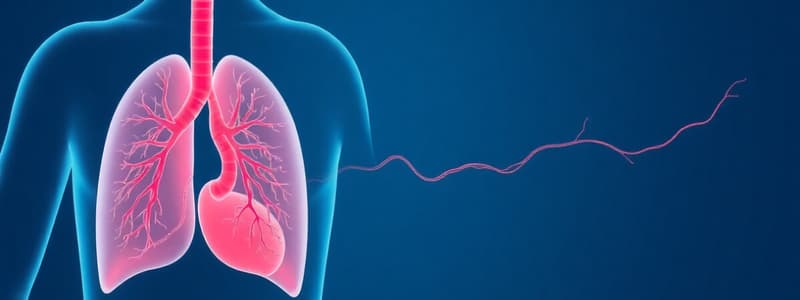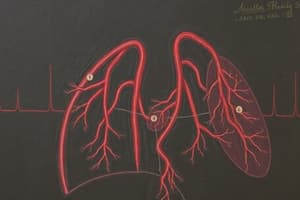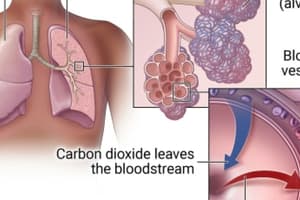Podcast
Questions and Answers
What is the average diameter of pulmonary capillaries?
What is the average diameter of pulmonary capillaries?
- 8 μm
- 4 μm
- 10 μm
- 6 μm (correct)
Which of the following statements is true regarding red blood cells (RBCs) passing through pulmonary capillaries?
Which of the following statements is true regarding red blood cells (RBCs) passing through pulmonary capillaries?
- RBCs do not engage in gas exchange until they exit the lungs.
- RBCs retain their shape while passing.
- RBCs must change shape slightly as they pass through. (correct)
- RBCs pass through only one pulmonary capillary at a time.
What initiates gas exchange in pulmonary circulation?
What initiates gas exchange in pulmonary circulation?
- At the alveoli exclusively.
- In smaller pulmonary arterial vessels. (correct)
- Only at the level of capillaries.
- Along the entire length of the pulmonary arteries.
What influences changes in pulmonary vascular resistance (PVR)?
What influences changes in pulmonary vascular resistance (PVR)?
Which of the following components is NOT part of the pulmonary capillary structure as described?
Which of the following components is NOT part of the pulmonary capillary structure as described?
What is the primary function of the pulmonary system?
What is the primary function of the pulmonary system?
Which factor does NOT influence the diffusion rate of gases in the lungs?
Which factor does NOT influence the diffusion rate of gases in the lungs?
What occurs at the surface of the alveoli?
What occurs at the surface of the alveoli?
Hypoxic pulmonary vasoconstriction primarily serves to:
Hypoxic pulmonary vasoconstriction primarily serves to:
What anatomical feature of the lungs is essential for adequate gas exchange?
What anatomical feature of the lungs is essential for adequate gas exchange?
Which statement about CO2 and O2 diffusion in the lungs is true?
Which statement about CO2 and O2 diffusion in the lungs is true?
What significant effect does increased lung volume have on pulmonary vascular resistance?
What significant effect does increased lung volume have on pulmonary vascular resistance?
Elevated intravascular pressures generally lead to:
Elevated intravascular pressures generally lead to:
What characterizes the arterial circuit compared to systemic vessels?
What characterizes the arterial circuit compared to systemic vessels?
Where does the venous circuit start in the pulmonary circulation?
Where does the venous circuit start in the pulmonary circulation?
How much blood is typically found in the pulmonary circulation per square meter of body surface area?
How much blood is typically found in the pulmonary circulation per square meter of body surface area?
What is the role of lymphatics in the pulmonary circulation?
What is the role of lymphatics in the pulmonary circulation?
How long does it typically take for a red blood cell to travel through the pulmonary circulation?
How long does it typically take for a red blood cell to travel through the pulmonary circulation?
Which structure drains into the left atrium in the venous circuit?
Which structure drains into the left atrium in the venous circuit?
What feature makes pulmonary veins different from systemic veins?
What feature makes pulmonary veins different from systemic veins?
In terms of structure, what role does the alveolar septum play in the pulmonary circulation?
In terms of structure, what role does the alveolar septum play in the pulmonary circulation?
What condition can lead to hypoxia during exercise?
What condition can lead to hypoxia during exercise?
Which of the following describes the function of the bronchial circulation?
Which of the following describes the function of the bronchial circulation?
What happens to pulmonary blood flow during exercise?
What happens to pulmonary blood flow during exercise?
What impact does lung fibrosis have on diffusion?
What impact does lung fibrosis have on diffusion?
Which of the following best explains V/Q mismatching?
Which of the following best explains V/Q mismatching?
Which part of the pulmonary blood flow participates in gas exchange?
Which part of the pulmonary blood flow participates in gas exchange?
What is the blood flow percentage of the bronchial circulation compared to the left ventricle output?
What is the blood flow percentage of the bronchial circulation compared to the left ventricle output?
What happens to oxygenation when pulmonary blood flow is blocked, as in a pulmonary embolus?
What happens to oxygenation when pulmonary blood flow is blocked, as in a pulmonary embolus?
What is typically observed in the pulmonary circulation in terms of pressure?
What is typically observed in the pulmonary circulation in terms of pressure?
What does diffusion limitation refer to in the context of pulmonary function?
What does diffusion limitation refer to in the context of pulmonary function?
What primarily regulates pulmonary blood flow?
What primarily regulates pulmonary blood flow?
What is the main factor influencing hypoxic vasoconstriction in pulmonary circulation?
What is the main factor influencing hypoxic vasoconstriction in pulmonary circulation?
What occurs as an adaptive mechanism during hypoxia in the lungs?
What occurs as an adaptive mechanism during hypoxia in the lungs?
What happens to pulmonary blood flow in widespread lung disease?
What happens to pulmonary blood flow in widespread lung disease?
What mechanism allows O2 to affect vascular smooth muscle in pulmonary arterioles?
What mechanism allows O2 to affect vascular smooth muscle in pulmonary arterioles?
How does normal PAO2 affect arteriolar smooth muscle cells?
How does normal PAO2 affect arteriolar smooth muscle cells?
What formula defines pulmonary vascular resistance (R)?
What formula defines pulmonary vascular resistance (R)?
Which of the following statements is true regarding hypoxic vasoconstriction?
Which of the following statements is true regarding hypoxic vasoconstriction?
Flashcards
Pulmonary Circulation
Pulmonary Circulation
The part of the circulatory system responsible for gas exchange in the lungs.
Alveoli
Alveoli
Tiny air sacs in the lungs where gas exchange occurs.
Diffusion
Diffusion
The passive movement of a substance from an area of high concentration to an area of low concentration.
Ventilation
Ventilation
Signup and view all the flashcards
Gas Exchange
Gas Exchange
Signup and view all the flashcards
Pulmonary Vascular Resistance
Pulmonary Vascular Resistance
Signup and view all the flashcards
Hypoxic Pulmonary Vasoconstriction
Hypoxic Pulmonary Vasoconstriction
Signup and view all the flashcards
Total Alveolar Surface Area
Total Alveolar Surface Area
Signup and view all the flashcards
Diffusion Limitation
Diffusion Limitation
Signup and view all the flashcards
V/Q Mismatch
V/Q Mismatch
Signup and view all the flashcards
Bronchial Circulation
Bronchial Circulation
Signup and view all the flashcards
Pulmonary Circulation
Pulmonary Circulation
Signup and view all the flashcards
Pulmonary Blood Flow
Pulmonary Blood Flow
Signup and view all the flashcards
Ventilation/Perfusion Ratio (V/Q)
Ventilation/Perfusion Ratio (V/Q)
Signup and view all the flashcards
Exercise Hypoxia
Exercise Hypoxia
Signup and view all the flashcards
Bronchopulmonary Anastomosis
Bronchopulmonary Anastomosis
Signup and view all the flashcards
Pulmonary Circulation Division
Pulmonary Circulation Division
Signup and view all the flashcards
Pulmonary Blood Pressure
Pulmonary Blood Pressure
Signup and view all the flashcards
Arterial Circuit (Lungs)
Arterial Circuit (Lungs)
Signup and view all the flashcards
Venous Circuit (Lungs)
Venous Circuit (Lungs)
Signup and view all the flashcards
Pulmonary Capillaries
Pulmonary Capillaries
Signup and view all the flashcards
Lymphatics (Lungs)
Lymphatics (Lungs)
Signup and view all the flashcards
Blood Volume (Pulmonary Circulation)
Blood Volume (Pulmonary Circulation)
Signup and view all the flashcards
Capillary Blood Time
Capillary Blood Time
Signup and view all the flashcards
Pulmonary Vein Functionality
Pulmonary Vein Functionality
Signup and view all the flashcards
Alveolar Septum
Alveolar Septum
Signup and view all the flashcards
Pulmonary capillary size
Pulmonary capillary size
Signup and view all the flashcards
RBC shape change
RBC shape change
Signup and view all the flashcards
Functional pulmonary capillaries
Functional pulmonary capillaries
Signup and view all the flashcards
Pulmonary vascular resistance
Pulmonary vascular resistance
Signup and view all the flashcards
Active PVR alteration
Active PVR alteration
Signup and view all the flashcards
Pulmonary blood flow regulation
Pulmonary blood flow regulation
Signup and view all the flashcards
Pulmonary vascular resistance (R)
Pulmonary vascular resistance (R)
Signup and view all the flashcards
Hypoxic vasoconstriction
Hypoxic vasoconstriction
Signup and view all the flashcards
PAO2 effect
PAO2 effect
Signup and view all the flashcards
Hypoxic vasoconstriction benefit
Hypoxic vasoconstriction benefit
Signup and view all the flashcards
Hypoxic vasoconstriction mechanism
Hypoxic vasoconstriction mechanism
Signup and view all the flashcards
Oxygen and Vessel Relaxation
Oxygen and Vessel Relaxation
Signup and view all the flashcards
Hypoxia and Vessel Constriction
Hypoxia and Vessel Constriction
Signup and view all the flashcards
Study Notes
Pulmonary Circulation Physiology
- Pulmonary circulation facilitates gas exchange between the environment and the circulatory system
- Oxygen (O2) is inhaled, diffuses into the blood, enters systemic circulation, and produces ATP for cellular energy
- Carbon dioxide (CO2) and metabolic byproducts are exhaled
- Lungs contain alveoli (air sacs), approximately 300 million in healthy lungs
- Gas diffusion occurs at the alveoli surface into pulmonary arterioles
Learning Objectives
- Understand bronchial and pulmonary circulation, anatomy, and physiology
- Compare and contrast pulmonary and systemic circulation
- Describe effects of lung volume on pulmonary vascular resistance
- Explain effects of elevated intravascular pressures on pulmonary vascular resistance
- Identify neural and humoral factors that influence pulmonary vascular resistance
- Describe interrelationships of alveolar, pulmonary arterial, and pulmonary venous pressure, and their effects on pulmonary blood flow
- Describe hypoxic pulmonary vasoconstriction and its role in localized and widespread alveolar hypoxia
Diffusion
- Diffusion is passive movement from higher to lower concentration
- Ventilation moves air into and out of the lungs
- Oxygen is high in concentration in the lung and lower in pulmonary capillaries
- Carbon dioxide is lower in concentration in the lung and higher in pulmonary capillaries
- Diffusion rate depends on gas solubility, density, and available surface area in the lung
Diffusion (part 2/4)
- Carbon dioxide is highly soluble, so oxygen is the primary limiting factor in diffusion
- Total available surface area is a key factor in pulmonary pathology
- Reduced alveolar surface area relative to arteriolar perfusion decreases oxygen diffusion into the blood, potentially causing hypoxia
Diffusion (part 3/4)
- Diffusion limitation occurs when oxygen movement from alveoli to pulmonary blood vessels is impaired
- Lung fibrosis and parenchymal destruction reduce alveolar surface area
- Perfusion is blood flow through the lungs
- Ventilation/perfusion ratio (V/Q) measures gas exchange efficiency in the lungs
- V/Q mismatching often coexists with diffusion abnormalities, prevalent during exercise
Diffusion (part 4/4)
- Resting blood flow in lung arterioles is slow, allowing sufficient diffusion time
- Exercise increases cardiac output, reducing oxygenation time and possibly causing transient hypoxia
- Lung fibrosis and COPD are examples of limited diffusion diseases
Pulmonary Circulation
- The lung receives blood flow via bronchial and pulmonary circulation
- Bronchial blood flow is part of systemic circulation, supplying oxygenated blood to the lungs
- Pulmonary blood flow carries deoxygenated blood to the lungs for oxygenation and returns oxygenated blood to the heart
Bronchial Circulation
- Bronchial arteries arise from the aorta, or intercostal arteries
- They supply arterial blood to the tracheobronchial tree and terminal bronchioles
- They also supply blood to hilar lymph nodes, visceral pleura, pulmonary vessels, vagus, and esophagus
- Lung tissues distal to terminal bronchioles receive oxygen directly through diffusion from alveolar air and nutrients from mixed venous blood in pulmonary circulation
- Bronchial blood flow accounts for about 2% of the left ventricle output
- Bronchial artery pressure is similar to other systemic arteries, but higher than pulmonary artery pressure
Blood Flow to the Lung
- Histologists have identified anastomoses between bronchial and pulmonary capillaries and arteries
- These connections are generally minor in healthy individuals but can be important in pathological conditions
- Blood flow to a portion of the lung can be impacted by either bronchial or pulmonary occlusion, with bronchial flow to that area increasing
Pulmonary Circulation (Part 2)
- Pulmonary blood flow undergoes gas exchange within pulmonary capillaries
- Blood flow equals approximately 100% of left ventricular output
- Approximately 3.5 L/min/m² of blood flow at rest with 280 billion pulmonary capillaries supplying ~300 million alveoli
- One arteriole and venule supply and drain a pulmonary lobule
Pulmonary Circulation: A Low-Pressure System
- Diagram illustrating the pulmonary circulation and its low-pressure system flow
Pulmonary Circulation Divisions
- Pulmonary circulation is divided into 3 parts: arterial circuit, venous circuit, and lymphatics
Arterial Circuit
- Originates from the main pulmonary artery, arising from the right ventricle
- It runs a short course (~5cm), then divides into the right and left main branches further dividing into smaller arteries, arterioles, and capillaries
- The vessels are thinner than systemic vessels (1/3 thickness) and have a larger diameter, making them more distensible and compliant
Venous Circuit
- Venules drain capillaries forming smaller veins ultimately connecting to the main pulmonary veins, draining into the left atrium
- Pulmonary veins are also thinner and more distensible than systemic veins, accommodating more blood due to greater compliance
Lymphatics
- Lymphatics are crucial in maintaining a dry alveolar membrane, preventing the accumulation of tissue fluid around the pulmonary circulation
- They are located near terminal bronchioles
- They drain mediastinal lymphatics and ultimately empty into the right lymphatic duct
Pulmonary Veins and Arteries
- Diagram showing the pulmonary veins and arteries within the lungs
Pulmonary Vascular Resistance
- PVR is calculated as (MPAP-MLAP)/PBF, which is equal to the cardiac output, reflecting the resistance to flow in the pulmonary vascular system
Pulmonary Vascular Resistance (Part 2)
- Pulmonary blood flow is pulsatile and can be turbulent
- Pulmonary circulation is distensible and compressible
- Complex branching structure of the pulmonary circulation impacting the pressure gradient
- Mean left atrial pressure might not accurately represent downstream pressure in various lung conditions
Pulmonary Vascular Resistance (Part 3)
- Right and left ventricular outputs must be approximately equal for prolonged stability preventing fluid buildup in the lung or periphery
- Given a drop in pressure across systemic and pulmonary circulation of about 98 mmHg vs 10 mmHg for the respective systems, pulmonary vascular resistance is ~1/10th of systemic vascular resistance
Pulmonary Vascular Resistance (Part 4)
- Low resistance in pulmonary circulation relates to thinner walls with less vascular smooth muscle, offering greater distensibility than systemic circulation
Distribution of Pulmonary Vascular Resistance
- Pressure distribution of the pulmonary vasculature is evenly distributed throughout the pulmonary arteries, capillaries, and veins
- Pulmonary vasculature differs from systemic vasculature by uneven pressure distribution across the lung areas
Distribution of Pulmonary Blood Flow
- Blood flow in the lungs is unevenly distributed and influenced by gravity
- Supine position results in a more uniform distribution
- Upright positions exhibit the lowest flow at the apex and highest at the base due to gravitational influence on hydrostatic blood pressure
Zone 1 Distribution of Pulmonary Blood Flow
- Gravity-dependent arterial pressure can be lower than alveolar pressure at the lung apex
- This compression can cause capillary closure, although perfusion still occurs at low flows
Zone 2 Distribution of Pulmonary Blood Flow
- Higher arterial pressure than alveolar pressure due to gravity's effect, with blood flow driven by the difference between arterial pressure and alveolar pressure, not arterial vs venous, unlike systemic blood flow
- Capillary compression isn't a concern
Zone 3 Distribution of Pulmonary Blood Flow
- Gravity-dependent increased arterial and venous pressure, and both are higher than alveolar pressure
- Blood flow is driven by the difference between arterial and venous pressure
Common Pathologies of the Pulmonary Circulation
- Pulmonary edema: any disturbance in the pulmonary circulation causing fluid accumulation in alveoli and respiratory distress; causes can be cardiogenic or non-cardiogenic
- Pulmonary embolism: dislodged clot causing ischaemia and potential lung parenchyma infarction due to impaired gas exchange; common origin is a deep vein thrombosis
- Pulmonary hypertension: elevation of MPAP above 25mmHg, leading to impaired gas exchange and exertional dyspnea
- Pleural effusion: accumulation of fluid in the pleural space leading to pleuritic chest pain and respiratory distress
Conclusion
- Compared to systemic arteries, pulmonary arteries have significantly less vascular smooth muscle, resulting in lower resistance to blood flow due to the lower vascular transmural pressure gradient
- Passive factors play a more prominent role in pulmonary vascular resistance than neural and humoral factors in contrast to those in systemic circulation
- PVR typically decreases in relation to increase in pulmonary blood flow, pulmonary artery pressure, left atrial pressure, and pulmonary capillary blood volume due to vessel distention
- Blood flow in lower lung regions is typically more ample than in the upper regions
- Alveolar hypoxia or hypercapnia causes constriction of pre-capillary vessels diverting blood away from poorly ventilated regions of the lungs
Recommended Further Literature
- "Physiology" by Linda S. Costanzo (6th Edition) is recommended for further study
Studying That Suits You
Use AI to generate personalized quizzes and flashcards to suit your learning preferences.




